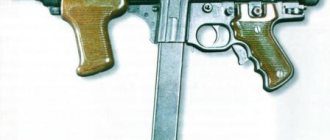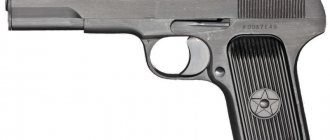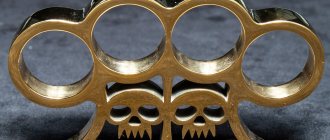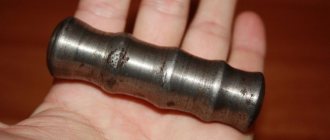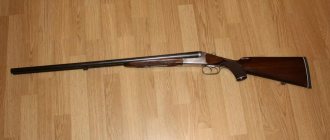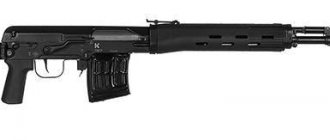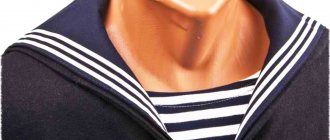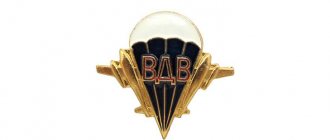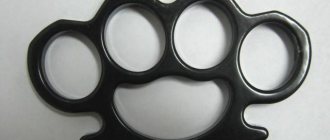You can't harness it to one cart
A horse and a trembling doe.
A.S. Pushkin
The favorite weapon of French punks and bandits of the late 19th and early 20th centuries was brass knuckles (from the French “castete” - literally “puzzle”, in the sense of puzzling).
The First World War gave birth to trench knives, which are a combination of brass knuckles and a fixed blade knife.
Trench knuckle knife of the First World War
Of these, perhaps the most famous is the American trench knife of the 1918 model, which can be found in Chinese clone models on our market.
You can read more about brass knuckles and trench knives in the publications of the “Brother” magazine, available in the archive of this magazine’s website.
After the First World War, such knives were replaced by more advanced combat and tactical knives.
In the mid-1980s. The movie “Cobra” with Stallone in the title role was released.
"Scaler"
Probably the first brass knuckle knife that became available in knife stalls in the 90s. became a Chinese knife - a double karambit of a rather terrible appearance. It was popularly nicknamed “fish scaler” for the characteristic teeth on the bow of the brass knuckle hilt.
In its classic form, a folding knife-knuckles has a handle made in the form of brass knuckles, into which a small blade is removed, the length of which is slightly less than the length of the handle.
Model features
One look at the Apache shooting knife is enough to understand its purpose in real life. As a firearm, this model is effective at a distance not exceeding 3 meters. There is no barrel here, and a 7 mm caliber bullet is not able to provide a high stopping effect due to the low initial flight speed. That is, the point of a revolver in this model is to become a weapon of last chance.
The blade of the shooting knife is 89 mm long and is not intended for attack. It is almost impossible for them to seriously injure the enemy, and it is not even that he is too short for this. Just look at how it is attached and you will immediately understand everything. It is only enough for one serious blow, and even then, it is better to do this after the drum of the built-in revolver is completely empty.
A menacing-looking brass knuckle is practically unsuitable for use in practice, since the massive drum for such a fragile weapon simply does not allow you to firmly grasp the weapon with a brass knuckle grip. I am sure that no sane person who owns a gun would hope for such a decorative model.
But the Apache will come in handy as a weapon of last chance. At such moments, a person’s life may depend on one bullet or a single blow from a blade. Therefore, even such a weapon, provided it is maintained in working order, can provide an invaluable service to its owner.
It is unlikely that this unusual model was used as a self-defense weapon. Even modern gopniks, accustomed to robbing with their bare hands, will not be afraid of this ridiculous contraption. And about the Parisian Apaches, accustomed to looking death in the eyes every day, I am generally silent. It can only be used suddenly, and the blade is only enough for one precisely aimed blow.
Knife with brass knuckles frame
Knives in which the handle is made in the form of a detachable frame do not have this drawback.
The Chinese even produce brass knuckles balisong. But, of course, there can be no talk of any flipping in this case.
The “M-Tech NKOK402” brass knuckle knife stands out from the mass of similar products.
Components
This illegal type of weapon is very difficult to make with your own hands. Comprises:
- stop;
- racks;
- warhead (frame);
- finger holes;
- protrusions with spikes;
- short blade.
Some models include:
- knife with brass knuckles;
- plate with blade;
- metal cylinder;
- sharp curved blades with a metal plate;
- round rod;
- wooden base;
- valve.
Karambit-knuckles “M-Tech”
In some online stores it is called brass knuckles-karambit. But the only thing it has in common with knives like karambit is the ring on the handle. Unlike other knuckle knives, its striking part is formed not by the handle, but by the butt of the blade with three round slots for the fingers.
In addition to knives with a full-size blade, there are also brass knuckles with a small “claw” type blade.
Despite their ominous appearance, brass knuckles, like the brass knuckles themselves, do not add much effectiveness to the knife in hand-to-hand combat.
The history of brass knuckles
History of brass knuckles.
Scientists suggest that it began in the 3rd century BC in Greece. The Greeks depicted parts of the product that looked like a boxing glove. The device was called a cestus.
In ancient times they were made from straps. The warriors wrapped their hands and went into battle.
But a number of scientists do not agree with this opinion, since the glove facilitates the blow, and brass knuckles, on the contrary, should increase injuries.
They appeared in European countries in the 19th century. The blacksmiths made holes in the metal bar. Manufacturing began in Russia during the reign of Nicholas 2.
The device was indispensable during the First World War. American and French soldiers needed specialized and effective weapons. The best option was brass knuckles.
The prototype is a Lebel rifle needle bayonet. The 1888 sample was shortened from 52.07 to 15.24 cm. The blade was sharpened following the example of a sword. This results in unsurpassed penetrating power.
Knife "Boker-Plus MA-2"
A much more effective weapon is the small MA-2 self-defense knife, created by Americans Richard Miltner and Julia Adams. In a slightly modified form (simplified design of the cutting edge of the blade and plastic sheath), it was also available in Russian stores as “Boker Plus MA-2”. With a certain grip of this small skeleton knife, it turned into a cutting weapon with a brass knuckle grip.
The attitude of the authorities towards brass knuckles at different times
Until a certain time, the weapon was legalized. Even ordinary people were allowed to keep it. In some countries, carrying and storage are still allowed:
- in China;
- in Turkey;
- in Thailand;
- in Brazil.
Several European countries only allow storage of the device. In Russia, the GOST R51215-98 standard is classified as edged weapons. Forbidden:
- acquisition;
- wearing;
- application;
- manufacturing.
The ban is absolute and has no exceptions. There is no license for this type. Not used as a civilian or hunting weapon.
Jujutsu weapon - musashi kaiken
However, oddly enough, knives of this type have a household counterpart - the national Eskimo knife - ulu.
A – a modern version of the Eskimo ulu utility knife; B – field multifunctional tool “TOPS ATAX”; B – cutting knife “FOX 2 ULU”; G – tactical hatchet “UlAxe” from “American Kami”.
This Eskimo knife served as the prototype for several interesting knives, including the ATAX field multitool, the 2ULU carving knife, and the UlAxe tactical hatchet. All these knives can be used as self-defense knives with brass knuckles in a critical situation.
The history of this strange weapon
The history of the appearance of such an exotic weapon is mysterious and completely incomprehensible. The only thing that can be said with 100% certainty is that this weapon was created in France. Indeed, who else besides the sophisticated French could come up with such a strange murder device? There are two versions of the appearance of the dagger-revolver-brass knuckles.
According to the first version, the Apache dagger-revolver was invented by Parisian hooligans and bandits calling themselves Apaches. I’ve heard about this subculture for a long time, but I couldn’t imagine that the word “Apache” is translated from French as “Apache.” And the Apaches, as you know, terrified the entire Wild West at one time.
So the French hooligans, who learned about the Apaches thanks to traveling circuses, decided to surpass them in cruelty and “glorious” exploits. They became famous as cruel and unscrupulous bastards, not above using knives, daggers and revolvers. It was not only ordinary Parisians who suffered from the French Apaches. They were constantly at odds with each other. It is believed that they were the ones who invented the Apache shooting knife.
But where did the French “gopniks” get the money for such an exotic weapon, which was also developed by someone else? It is unlikely that professional bandits and criminals would bet on such a fragile and elegant thing, because their lives directly depended on the quality and reliability of the weapon.
According to the following version, the Apache shooting knife appeared due to the fierce competition of French weapons manufacturers. To attract potential buyers, new models were invented, and the filigree finish of the Apache hints that this weapon simply could not be cheap.
Indeed, most models of Apache shooting dagger-revolvers that have survived to this day have not only engravings on metal parts. But also trimmed with gold and silver.
Please note: Stone Age weapons.
And only the rich could buy such an elegant weapon, not understanding that the simpler any weapon, the more reliable it is.
Trident dagger
Bokken / wikimedia commons / CC BY-SA 3.0
Share
During the Middle Ages, trident dags were developed in Europe. These were mechanical daggers in which, when the handle was pressed, the sides of the blade folded to the sides and were set at an angle to the main blade. In France, such a weapon was called men-gauche (main-gauche, left hand). They were used in battle along with the main weapon - a rapier or sword.
At first glance, it may seem that such weapons were used to inflict heavy damage on the enemy. In fact, trident dags were used for protection. Their unfolded blade served as a guard, that is, it could be used to stop the enemy’s blade. It was possible to kill an enemy with a trident dagger if such an opportunity presented itself in battle. Less common than trident dags were sword smashers. They were short swords, the blade of which had several slots in the upper part. In one of these slots it was possible to catch the enemy's sword and, with a jerk of the crusher, break the blade.
Shovel mortar
Maria Sergeevna Shalaeva / wikimedia commons / CC BY-SA 4.0
Share
At the beginning of the Great Patriotic War, the VM-37 mortar was adopted by the Red Army, which was supposed to also serve as a shovel for infantrymen. The handle of the shovel was, in fact, the barrel of the mortar, and the shovel served as a base plate for firing the mortar. The resulting “hybrid” was very inconvenient to dig (the handle was too thick), and the mortar turned out to be a very weak weapon: to lighten the weight, the walls of its barrel were made very thin, and the barrel itself was only 40 centimeters long. As a result, the VM-37 projectile was equipped with a small powder charge, and at best flew 200 meters. And the mines themselves, limited to a caliber of 37 millimeters, had low lethality.
At the front, all the shortcomings of the multi-purpose miracle weapon became completely clear. The soldiers complained not only about the low range of the shovel, but also about the poor accuracy of its fire. In addition, from frequent use, the bayonet of the shovel (aka the mortar base plate) bent, and digging became even more inconvenient. Less than a year after the appearance of the VM-37 in the hands of the Red Army, the shovel mortar was removed from service.
Ring gun
Breshvic / CC BY-SA 3.0
Share
In the 19th century, compact means of self-defense were developed in France - the Le Petit Protector and Femme Fatal fire rings. These were rings designed to be worn on the middle finger and equipped with a small revolving drum. The rings were loaded with 2 or 4 mm caliber cartridges. On the back side of the drum, on both sides of it, there was a trigger and a trigger. When the hammer was cocked, the trigger extended. The cartridges had a firing pin built into the side of the cartridge case, which was hit by the trigger of the firing ring.
Fire rings were developed by French engineer Casimir Lefaucheux in 1828. They came in a wooden box with six cartridges and cleaning tools. The energy of the rings' shot was very small, and it was almost impossible to kill a person with their help. However, such rings made it possible to slightly injure the offender, which gave time to leave the scene of the conflict.
rocket wheel
© IWM IWM FLM 1627
Share
In the second half of 1943, the British Admiralty introduced a self-propelled rocket bomb, which was called the "Great Panjandrum". At that time, preparations were being made for the landing of Allied troops in Normandy. They had to break through the German defense line, which consisted, among other things, of concrete fortifications. The British bomb consisted of two metal wheels with a diameter of three meters, connected to each other by a metal barrel. The latter was filled with explosives. On each of the wheels there were nine pairs of rocket powder engines.
The designers of the “Great Panjandrum” assumed that, with the help of rocket engines, a self-propelled bomb would be able to roll up along the coast to concrete fortifications at speeds of up to 90 kilometers per hour, rest against them and explode. On paper, everything worked out smoothly, but tests that took place at the beginning of 1944 showed the complete uselessness and even danger of a self-propelled bomb. Rocket engines often fell off the wheels, and the bomb itself, even on a perfectly flat surface, could unpredictably change its direction of movement, including turning 180 degrees.
The Great Panjandrum had another serious drawback. When a bullet hit a container with explosives, the bomb immediately exploded. Since the bombs were supposed to be carried with the soldiers on landing platforms during the Normandy landings, a stray bullet hitting the Great Panjandrum could have killed hundreds of allies. So the project was scrapped.
Ax pistol
Topory / wikimedia commons / CC BY-SA 3.0
Share
Weapons have always evolved consistently, and sometimes hybrid models have appeared at the intersection of different technologies. Thus, in the 17th century, pistol axes appeared in Germany, Poland and some other European countries. The pistols themselves were relatively standard for that time: muzzle loading with gunpowder and a bullet, a flintlock mechanism for igniting the powder charge. Pistols have always been considered melee weapons, but at that time they were single-shot and after firing they had to be loaded again for a long time.
In active close combat, a long reload could cost the owner of the pistol his life. For this reason, the designers decided to combine firearms and bladed weapons in one. This is how pistol axes appeared: after a shot, the owner could try to fight off advancing opponents with an ax. For the same reasons, pistol knives were also in use in the 17th century. Their blade, like that of a pistol axe, was attached under the barrel. Some samples had a folding blade, which made the weapon more compact.
